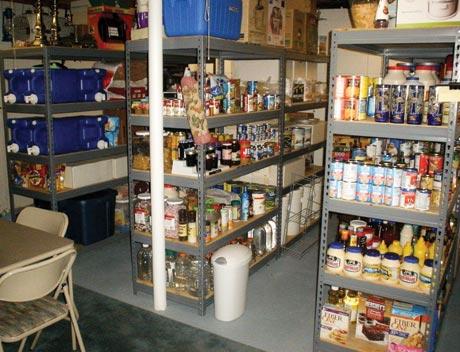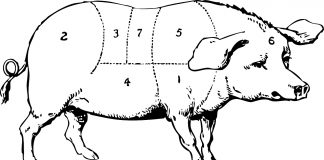| Issue #130 • July/August, 2011 |
This story begins in the mid-nineties when the Y2K threat was in the news. Several members of my family thought it would be prudent if we started stocking food just in case Y2K turned out to be the major problem that a lot of people predicted it would be.
We contacted a company that specialized in providing long-term foods to the public. Our order was not large enough, so we contacted a Mormon group that lived in a nearby town. They were delighted to have us go in with them on an order because they were just short of enough to place the order.
A few weeks later, we met in the small town and watched as an 18-wheeler rolled in with 73,000 pounds of food. This is how our food storage program began. We left there that day with more food than I had imagined. We had made some provisions for storing the food by buying some shelving, but it was barely enough to hold the two-year supply of food we had brought home.
As you all know, Y2K turned out to be a non-event. As time went on, a lot of our friends began doing away with their stored foods, either by giving it away or consuming all of it with no thought that it might come in handy later on. We knew that what we had was long-term foods and they would still be good for years. The problem was that we didn’t know very much about planning a storeroom for people that lived in a city. We wanted to keep what we had and make it the core of a storeroom that would provide for us and our extended family.
Backwoods Home was a great help along the way. The information we gained from the magazine and other sources kept us from making a lot of mistakes and gave us ideas that we could put to our use. I recognized the need for a plan for a storeroom for city folks. The key for that storeroom was shelving.
|
Shelving
Most of the information that I had read dealt with building shelving from scratch using wood. Living in a subdivision and not having the tools or skills to make our own shelving, I ruled out that option. Since we had already bought some shelving to store our long-term foods, we decided to continue with that method. This works out well because the shelves can be taken down and moved, if necessary. In our case, that was a plus because we did buy a place in the country and had to move all of our food at that time.
I like to call a set of shelving a module because my plan is expandable by adding modules as they are needed. That is also why I wanted to write about this project, in hopes that it might help others get started with a storage program of their own, by starting with one module and doing it one step at a time.
The shelving kits we used are the Muscle Rack 5500 series. They cost around $70 at Lowe’s. The shelving is rated at 5,000-pound capacity. They are 48 inches long, 24 inches wide and 72 inches tall and have five shelves. The shelves are adjustable in 1.5-inch increments.
The box states that the unit can be assembled in 30 minutes. Once you get the hang of it, you can do it in less time. The only tool needed is a hammer. I have gotten good results with a rubber mallet. One person can do the job, but it is much easier and safer if two people do it. I strongly recommend that the shelf boards that come with the kit not be used. The shelf boards are heavy-duty particle board but they will not support the weight of canned goods for very long without sagging. Lowe’s carries plywood sub-flooring that works fine for shelf boards. I wouldn’t use anything less than 5/8-inch thick. One 4×8 sheet will make four shelves and they charge a nominal fee to cut it for you. Buy the cheap grade of plywood. It doesn’t have to be pretty, just strong. Once completed, you will have 20 running feet of shelf space and the start of a storage program. Since this shelving is free standing, it is important to always load the heaviest items on the lowest shelves to reduce the chance that the shelves will tip over. Never use the lower shelf as a step up to reach something from a high shelf.
Warning: The shelving used in the construction of this storeroom is industrial-strength steel. Using any shelving not rated such should not be used for obvious reasons.
One big advantage of a shelf module is that it can be loaded from either side. We date every perishable item that is placed on the shelf. You can load from one side and remove from the other if you want to. The rule is “first in, first out.” This will help you with a rotation plan and keep your stored foods fresh. We prepare our grocery list by walking through the storeroom and listing each empty space and buying a replacement item with a trip to the grocery.
|
Water storage
We all know that food storage is important, but you should make arrangements to store as much water as you can, also. A person can live for a long time without food. Water is critical for survival. We have two methods for storing our water that will provide several days’ worth of water for our needs. We purchased Aqua-Tainer brand water containers. These can be purchased from several places, but we bought ours from the sporting goods section at Walmart. We got two prices even at the Walmart stores. One Walmart had them for $10.80 and the other was a dollar more for some reason. I have seen them online for $16.95 plus shipping, so it pays to shop around.
I have found the Aqua-Tainer to be a quality product. The box shape makes them very easy to store on your shelves. Each one holds seven gallons of water. It comes complete with a spigot and an air vent. You must open the vent before opening the spigot or the water won’t flow. When the container is full, the water will come out almost as fast as from a kitchen faucet.
The second method we use to store water is saving plastic soda bottles and large juice jugs. Even 32-ounce Gatorade bottles make excellent water containers. We keep around 70 gallons in those alone. We keep our water for about six months before replacing it with fresh water. It is important when filling the plastic containers to fill them to the brim and to splash some of the chlorinated water into the lid. We try to avoid having any air space between the water and the lid.
Water filtration kit
We have a water filtration system that is made from a kit we purchased from Cheaper Than Dirt! (800-421-8047, www.cheaperthandirt.com). The kit is a Camp-352 by Monolithic and will filter to .5 microns and meets NSF standards. We plan to treat the filtered water, just to be on the safe side. The kit consists of a ceramic filter, a filter sock, and a spigot. The kit sells for $29.97 and does not include the buckets needed to assemble the filter. We purchased the two five-gallon buckets from Emergency Essentials for $7.95 each.
For less than $50, you can have a filter system that rivals one that costs around $200 and filters 14 gallons of water per day. The filter can be cleaned with a soft brush and by back flushing. By adding a Gamma Seal lid, you have the convenience of a screw-on lid. This system should last a pretty good while.
Food savers
I feel that one of the best investments a person can make for a storage program is a vacuum sealer for foods. It will pay for itself in being able to buy foods in bulk and re-packaging in smaller quantities. It can be used to seal dry foods also. We buy rice in large bags and freeze it for several days, then divide it into smaller bags and vacuum seal it. It is as hard as a rock and stacks very well on the shelves. Foods that are vacuum-sealed stay fresh for months without freezer burn. A good unit can be purchased at Walmart for around $70 dollars. I can’t say enough about this product.
Combining modules
By placing two modules side by side and bolting them together you can create space to store bulkier items. Each shelf is 4×4 feet and gives you 16 square feet of space. We use this space to store paper towels, toilet tissue, cleaning products, paper plates, and any other non-food item that doesn’t have a use-by date. We also stock items for ladies’ special needs. We store paper plates and cups to help conserve our water. Because water is critical, you don’t want to be wasting it to wash dishes.
|
Alternative cooking
We had all the food stored, but we didn’t have a viable method for cooking it. A two-burner Coleman camp stove didn’t provide the cooking time needed to cook a lot of the foods we had on hand, plus it is labor intensive because it requires constant attention by pumping the fuel tank and also the small tank. Gasoline is dangerous and breaks down over time, so we ruled that out and decided to go with kerosene. Kerosene will also be useful in space heaters and emergency lighting. It will store for long periods without breaking down. It will turn yellow, but that doesn’t seem to affect its quality. We live in an area where ice storms can happen anytime during the winter and we have been left without power for days at a time, so fuel reliability over the long term is critical.
I contacted a fuel oil company in our area and they gave us a 55-gallon drum and came out and filled it for us. I went to Northern Tool and bought a hand crank pump that screws into the top of the drum. This setup has kept us warm, snug, and fed when the power goes out.
I went online and located a two-burner kerosene stove that looked promising. It’s called the Butterfly Stove, and I got mine from St. Paul Mercantile (888-395-1164, www.stpaulmercantile.com). The stove sold for $120 with a small shipping charge. My brother wanted one also and the company gives a 10% discount for two. If you purchase four you get a 15% discount, so if several people want to go together you get a pretty good discount. The stove is 30 inches wide and 30 inches tall a nice height for cooking. The instructions for assembly left much to be desired, but with a little patience, one person can do it. The company also has a three-burner model.
The stove has a center reservoir which supplies both burners by gravity feed. The glass tank holds 1.8 quarts of fuel and can be refilled while the stove is in operation. While testing the stove I found fuel wasn’t going all the way around the wick. The burners are adjustable, so that wasn’t a problem. I had to loosen the adjustment screws and tilt the burners back and that solved the fuel flow problem. It is important that the stove be set up on a level surface. The height of the flame depends on the rate of fuel flow, so there is a lag between the time you turn the valve until you get the desired result. When first lit, the burners do smoke a little. Once the combustion chambers get hot, the smoke stops. In my opinion, this a dandy little lightweight stove that can cook a lot of food.
The Butterfly oven is a companion for the Butterfly stove. The oven was designed to fit on top of one of the burners. St. Paul Mercantile sells it for $55. The instructions are pitiful; you almost have to look at the picture to assemble it. It is a two-person job to put together. It warns that the sharp metal parts can cut and I will attest to that. After it was assembled I added some sheet metal screws to the corners at the top and a few other places. Even with all the problems I had putting it together, I have to say it’s a darn good little oven. The oven has inner baffles that make it very efficient for its size. It has a temperature gauge on the door. The temperatures are shown in centigrade, but you can find a conversion chart online to convert it to Fahrenheit. I decided to test the little oven by cooking two frozen biscuits. That is a pretty tough test and it passed with flying colors. The Butterfly oven works well on the side burner of an outdoor gas grill.
The Alpaca kerosene heater/cooker is a heavy-duty single burner stove with a tank capacity of .9 gallons. The top of the stove is configured like a gas range burner. We got it from Nitro-Pak Preparedness Center (800-866-4876, www.nitro-pak.com). We have used ours several times and it does a great job as a cooker as well as a room heater. As a heater, it works best with a pan of water over the burner because you can turn the burner up high without it smoking. The Butterfly oven will work on this stove. When we bought ours, the price was $65. Now the price is approaching $100. You can sometimes find them on eBay for much less. These two stoves and the oven should take care of all your cooking needs.
Should you decide to go with kerosene as your energy source, you should contact your local codes department to see if there are any restrictions on bulk storage.
|
Grain mill
Our long-term food supplies include around 300 pounds of wheat. Our problem was we had no means of milling the wheat. We ordered the best mill that Lehman’s Hardware had for less than $200 dollars (877-438-5346, www.lehmans.com). This mill came with both stone and iron burrs, and does a fine job of milling wheat almost as fine as store-bought flour. Lehman’s still carries the mill, but it only comes with iron burrs now. If you want good flour from your wheat you really need the stone burrs. Another mill that will fill the requirement having both types of burrs is the Wondermill Junior Deluxe from Homegrown Harvest (866-900-3321, www.homegrownharvest.com). I’m not going to list the features of this mill, but the company claims it is “the world’s best,” so it must be pretty good.
An electric grain mill is nice to have, if your budget will allow it. There are several good ones out there, but remember you won’t always have electricity available, so the hand-powered mill should be your first priority. I suggest that you mill some wheat and practice making bread. It is a good feeling to know that you can make bread from your storeroom if you ever have to.
SuperPails
Emergency Essentials carries most any dry food you would want in your storeroom in 6-gallon “SuperPails” which are equal to eight #10 cans. They have wheat (both hard and soft), corn, and all types of dried beans. We added popcorn and soybeans to our long-term storage. We use popcorn for corn meal and soybeans have many food uses.
When ordering SuperPails from Emergency Essentials (800-999-1863, www.emergencyessentials.com), your order must weigh at least 200 pounds. A few SuperPails will add up pretty quick. They charge $12 dollars shipping for any order over $120 and you can’t beat that.
|
Vitamins
One of my reference books advises that your storeroom should contain a large quantity of vitamin C. This is one vitamin your body doesn’t store and it is possible a survival diet won’t provide enough of this vital vitamin. Store it where light can’t get to it. It has a shelf-life of about five years.
For quite some time I have wanted to write about our storeroom and how it came about. Is this the best possible storeroom? Probably not. Is it flexible? Yes. Can anyone do it without any special skills? Yes. Is it expensive? No. Anyone can do it without busting the budget if it is done in baby steps like we did, one module at a time. I would caution that if this type of storage room is built in an above-ground room on a wood floor that some consideration be given to reinforcing the floor from underneath. Stored foods are extremely heavy.
Other books we found helpful when stocking our storeroom were Gateway to Survival is Storage by Walter D. Batchelor and Passport to Survival by Esther Dickey.




















I watched a video on yt where it was advised to keep your pastas and especially rice in original plastic bag packaging when you vacuum-seal, otherwise any sharp edges will puncture. Some advise cutting a tiny hole at the top of the plastic sack of rice/pasta so that the air in that will be vacuumed out as well as the outer vacuum-seal bag. Jackie Clay-Atkinson of Backwoods Home magazine highly recommends not vacuum sealing beans, flour, sugar, and such, but instead storing in original packaging in 5 gallon plastic, food-grade buckets, with rubber sealed screw-down lids that are air-proof, moisture-proof, and rodent-proof, because these items will not rancid, nor ruin from age for several years stored like this. Other type elaborate preservation for these foods is simply not necessary according to her lengthy experience. A very helpful article!!!!!!!!!
I have a full unfinished basement so have lots of storage room. I’m constantly adding new containers of water, but do not empty the old water. I figure it can be used for flushing toilets, doing laundry or with addition of bleach doing dishes. I suppose by boiling it could also be used for drinking. Also, I never store water above anything else. Containers do get old and leak which isn’t a problem as long as nothing else is below them.
I never put metal cans on metal shelves without a liner. I generally use cardboard from cereal boxes as liners. When double stacking cans I use a sturdy cardboard box usually from Aldi as they are already cutdown and hold 12 cans.
Protect your storage from mice. Mice absolutely love toilet paper, paper towels and tissue for building nests. I have a storage bucket labeled mouse traps/mouse poison which contains a jar of rancid peanut butter to use to bait traps. My late dh discovered that cans of expanding foam were great for blocking mice from getting into the house which reduced the mouse problem from serious to seldom.
I can tell you from experience that the “AquaTainers” don’t last more than 3-4 years. ALL of mine eventually cracked and leaked out.
Vitamin D3. Nano-colloidal silver and a machine to make more.
Free food safe plastic buckets available from bakeries. Use with appropriately-sized oxygen absorbers available for purchase online. I even store vacuum-sealed stuff in these for convenience. Beans, grains, flour. You can also oven can flour in half-gallon jars. (Lots of whole grain flour, ancient grains, rice.)
2-year supply of canning lids. (Canning jars.)
Hand crank grain mills work, but are exhausting.
Brewing supplies and bottle caps. Swing-top bottles are even better if you have enough of them, can be reused. Brewing is a terrific way to preserve a harvest. (enzymes) If necessary, for natural yeast, you can float a powdery apple, etc. Nice to have a well-stocked wine cellar. Brew a traditional beer with molasses and hops or other brewing herbs, very easy.
Sweeteners–sugar, honey, molasses, stevia. Even if you do not eat sugar, stock up. It has many uses, inc. barter, brewing, explosives, etc.
Salts–iodized, non-iodized, pickling salt, cure salt for meat and sausage makings. Casings, etc.. Manual sausage stuffer.
Dehydrators. I am sure there are directions online for simple solar dehydrators, but you will need a fan or breeze. (Leave ends open.) Pressure canners. Large kettles for water bathing.
Aluminum-free baking powder. Thickener such as cornstarch.
Heirloom garden seed, 3-year supply to allow for crop failures and replanting. Save your seed. Bird netting. Pest deterrents. Diatomaceous earth. Orchard sprays. Tools. Extra work gloves, sox.
Soaps, detergents, dish, laundry. Fels naptha, borax, washing soda (sterilize bottles for brewing, too).
For making your own vinegar, a hydrometer to test for 5% acidity so you know it is safe for canning–requires a bit of math and conversion tables. Too much to discuss here.
Food for animals.
Consider a homeopathic nosode kit and also a basic homeopathic first aid kit.
Isolate heirloom seed planted in your garden for cornmeal. I like Papa’s Red (very sweet) and Painted Mountain.
If a bug-out bag/location, a can/bottle openers. I also use the pointed end of bottle openers to shuck corn.
Know how to trap yeast and use sourdough. Lots of commercial yeast? Last years if kept cool the way it is packaged. Far beyond expiration date.
If you don’t have eggs, Bob’s Red Mill Egg Replacer or know how to substitute.
Powdered coconut milk or buttermilk, canned or boxed milks. For baking
Lots of extra virgin fats/oils!!! Many people ruin lard by overheating it when rendering. Slowly, never above 200-degrees. You want it white and fluffy, never yellow and burned.
magnesium striker for lighting fires.
In addition to ammo, there are advantages of archery–it is a quiet sport. Extra bow strings.
***I can’t grow rice. Does anyone have experience growing farro? Is seed avail? Climate and soil conditions? Harvesting by hand? Yield?